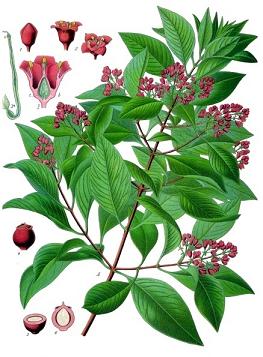The Santalum album tree, better known by its popular name as the sandal tree, was (and is) one of the most important sources for the production and production of perfumes, perfumes and medicines

Not many people mention the sandalwood when referring to the "Perfume Road" that crosses the Negev from east to west, perhaps because even today it is not known in our regions. The Santalum album tree, better known by its popular name as the sandal tree, was (and is) one of the important sources for the production and production of perfumes, perfumes and medicines.
All parts of the tree can be used and in every area where it grows it is attributed medicinal properties, perfumes and perfumes are made from the leaves, flowers, fruits, tree resin, trunk bark and roots, boxes for jewelry and perfumes made of wood are considered prestigious and special, the use of the branches and roots of the tree harms the tree and sometimes causes its destruction.
To get good extracts, it is desirable that the tree be thirty years old or more, the more mature the tree, the better the extracts produced, the sandalwood is resistant to drought and regenerates after a fire, which allows the existence of multi-year trees.
The origin of the tree is probably in India, but already hundreds of years ago it was found everywhere where there were suitable growing conditions from the Pacific Ocean to Africa, South America and Australia, this is because of the great importance attached to it wherever they learned to know it.
In the past, the extracts of the tree were used in the embalming process, (to absorb odors) in various religions, the smell of the sandalwood is considered to "bring the believer closer to his God", in India, the smell helps to concentrate in meditation, also the extracts are widely used by traditional doctors to treat stressful situations, in many regions peeling the The stem and the bark are cooked to produce a (medical?) drink. At the beginning of the twentieth century, sandalwood extracts were widely used to treat digestive disorders, disinfect wounds and treat ulcers. In the new industry, extracts are used to add flavors to prepared food.
In recent years, the modern cosmetic industries have "discovered" the possibilities that the tree offers, when its use is mainly as a setting for other perfumes and as a base for perfumes, a "discovery" that has raised the prices of the fatty extracts extracted from the tree to $1000 - $1500 per kg. As a result, thousands of trees are destroyed every year, the destruction that brought the tree to the brink of destruction.
The tree can be utilized in a sustainable manner by controlled picking of leaves, flowers, fruits and by gently peeling the bark of the trunk, this is indeed how the tree is utilized in India since all trees in India are considered the property of the government. Sandalwood plantations have recently been planted in Tamil Nadu, the plantations are associated with the residents and constitute "financial insurance" for them.
However, because of the increasing demand and the rising prices, it is worthwhile for the "sandalwood criminals" to take the risk and uproot trees by their roots, (slaughter the hen that lays golden eggs)!
In East Africa, a "task force" was established with the aim of preventing wild exploitation of the tree. The inspectors of the force are supposed to prevent the uprooting of the trees and their destruction by greedy enthusiasts, but the supervision is not easy because in order to prevent the wild trade that causes the destruction of the trees, the tree must have a "legal protective status", a status that does not yet exist.
In Kenya, the tree is given a status that allows its cutting, but after cutting, when the tree leaves the country's borders, there is no possibility of preventing the continued trade. To remedy the situation, the conservation authorities of Kenya turned to CITES (the International Convention on Trade in Plants and Wildlife) with a request to give the sandalwood tree a status to prevent its destruction. A suitable stand will allow protection of the tree wherever it grows, protection that will prevent the disappearance of an important and interesting plant.
Riddle (and a suggestion for a solution?): One of the most famous plants in (local) history, is the persimmon that was grown in Ein-Gadi and from which perfumes and perfumes were produced. There is no botanical identity of the persimmon and we do not know what it was, in the "Western Palace" in Masada there is a mosaic depicting palm branches, bunches of grapes and unidentified leaves... the leaves are similar in shape to sandalwood leaves... so maybe the farmers of ancient Ein-Gadi grew sandalwood... and called it persimmon?
Dr. Assaf Rosenthal,
Tour guide/leader in Africa and South America.
For details: Tel. 0505640309 / 077-6172298,
Email: assaf@eilatcity.co.il

3 תגובות
"In eating disorders"... Please correct - I assume it means indigestion
Does the plant exist in Israel?
Can it be purchased and if so where?
What happened, the persimmon was already discovered by a researcher (can't remember his name) from Bar Ilan. It is a tree (or bush) found in the gardens around the Kaaba (the black stone) in Saudi Arabia.